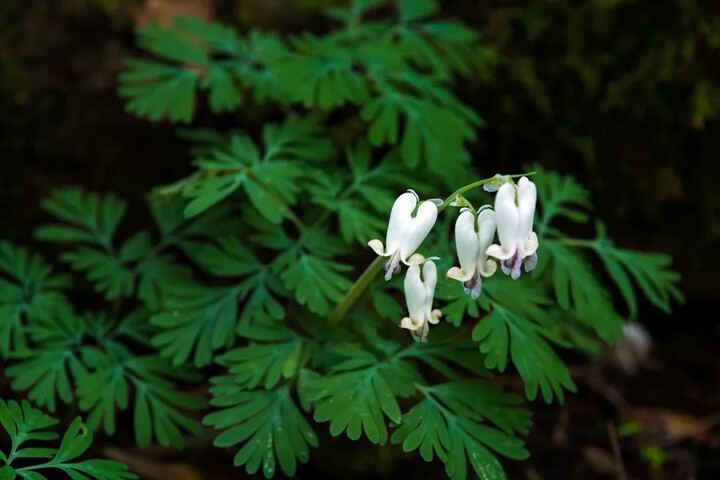Squirrel corn is a spring ephemeral, similar to Spring beauty (Claytonia virginica) or Trout lily (Erythronium americanum). It is grown mainly for its blooms, which, while merely 1 inch across, come in sufficient numbers to make for a good display if you mass enough of the plants together. In addition, the plant boasts attractive, fern-like leaves that are grayish-green or bluish-green on top, and a lighter green color on the bottom. Squirrel corn is valued for its ability to thrive in shaded conditions.
Botanical Name:
Dicentra canadensis (formerly, Bicuculla canadensis)
Common Name:
Squirrel corn
Plant Type:
Herbaceous perennial
Mature Size:
6 to 12 inches tall when in bloom (most commonly closer to 6 inches)
Sun Exposure:
Partial shade to full shade
Soil Type:
Rich, evenly moist, and well-drained
Soil pH:
Acidic
Bloom Time:
May in zone 5
Flower Color:
pinkish-white, often with a hint of lavender
Hardiness Zones:
4 to 7
Native Area:
North America
How to Grow Squirrel Corn
An easy plant to grow, one of the few challenges in growing squirrel corn will be to keep young children away from it, since the flowers, foliage, roots, seeds, and stems are all poisonous if ingested.
Squirrel corn plants can become naturalized if the climate and the growing conditions are right. In their native habitat, they commonly inhabit rocky hillsides in damp, shady forests—which offers you a hint that, while these plants like a consistently moist soil, they also demand well-drained ground. Work organic matter into the ground to give them nutrients.
Light
Squirrel corn performs best when given partial shade to full shade.
Soil
Grow squirrel corn in a loamy soil.
Water
While squirrel corn likes a well-drained soil, do not allow its soil to dry out in spring (which is the active growing season for the plant).
Fertilizer
Amend the soil every year with compost.
Plants Similar to Squirrel Corn
Close relatives to squirrel corn that the average gardener will be the most familiar with are the cultivated bleeding heart plants, but squirrel corn is also related to another wild plant, Dutchman's breeches (Dicentra cucullaria). The two plants can be easily distinguished from each other by looking at the flowers (but not their leaves, which are nearly identical): The flower of squirrel corn is heart-shaped, whereas that of Dutchman's breeches looks like an inverted pair of pantaloons. The two also differ in their underground plant parts: Those of squirrel corn are yellow and resemble corn kernels (thus the common name), while the corms of Dutchman's breeches are pinkish.
The cultivated members of the Dicentra genus most widely grown are:
Common bleeding heart (Dicentra spectabilis)
Fringed bleeding heart (Dicentra eximia)
How to Use Squirrel Corn in the Landscape
Use squirrel corn in your woodland garden or perennial shade garden where you want to have some interesting spring flowers to admire. Gardeners who value novelty are attracted to squirrel corn; you will likely be the only one in your neighborhood growing it. The shape of the flower is also unusual enough to inspire conversation when neighbors come to visit your garden. Gardeners in North America may want to grow it especially in gardens comprised of native plants. Good companion plants include:
Round-lobed hepatica (Hepatica americana)
Bloodroot (Sanguinaria canadensis)
All three are native perennials in eastern North America, require the same sun and soil conditions, and bloom in mid-spring.
A drawback in growing squirrel corn is that, since it is a spring ephemeral, it does die back in summer. If you want to avoid having the resulting gap in your shade garden, there is a trick you must learn. Be ready to have other plants take the place of your squirrel corn plants when they disappear.
Two solutions to the "gap" problem are:
Install impatient Lucy (Impatiens walleriana) plants around the area vacated by your squirrel corn. These annuals will give you color in summer and then die back in the fall, leaving the space clear again for when your squirrel corn re-emerges in spring.
For a longer-lasting solution, grow other shade perennials around the area that will fill in and bloom later than your squirrel corn.
You Might Like ...